Embracing Gothic castle-inspired design transforms a house into a sanctuary of dramatic elegance and timeless mystery. This architectural style, known for its soaring heights, intricate details, and imposing silhouettes, offers a unique opportunity to create a home that is both a fortress of solitude and a masterpiece of art. From the pointed arches that draw the eye upward to the rich, dark wood finishes that exude warmth and history, every element works in harmony. Building or renovating with these concepts in mind allows for a deeply personal space that feels grand, historic, and profoundly different from conventional homes.
1. Stone Facade with Pointed Arches

A defining feature of any Gothic castle is its formidable stone facade, which provides an immediate sense of permanence and history. Incorporating rough-hewn, irregularly shaped stones in shades of grey, charcoal, and mossy brown creates an authentic, weathered appearance. The exterior should be punctuated by prominent pointed arches, a hallmark of Gothic architecture, framing doorways and large windows. This combination not only establishes a dramatic first impression but also grounds the structure in classic medieval aesthetics. The robust texture of the stone contrasts beautifully with the elegant curves of the arches, creating a visually compelling and historically rich exterior that stands as a testament to enduring design.
2. Grand Entrance with Wrought Iron Gates
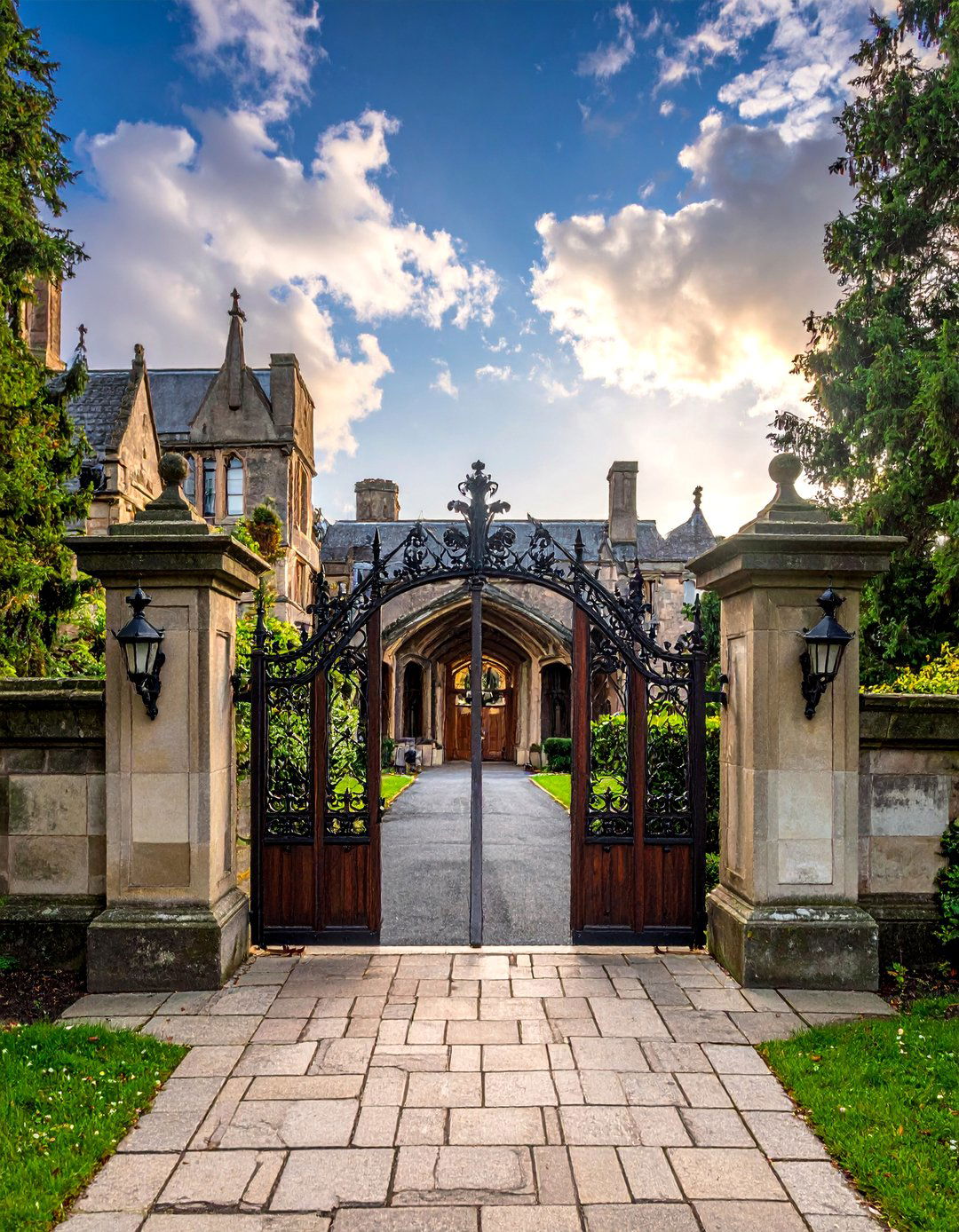
To capture the essence of a Gothic fortress, the entrance must be both imposing and intricately detailed. A grand entrance begins with massive, ornate wrought iron gates set between heavy stone pillars. These gates can feature complex scrollwork, fleur-de-lis motifs, or even a custom family crest for a personalized touch. Beyond the gates, a heavy, dark wood door with iron hardware, such as a large ring knocker and decorative strap hinges, completes the look. This layered entryway creates a sense of procession and ceremony, signaling a transition from the outside world into a private, dramatic domain filled with historic character.
3. Soaring Vaulted Ceilings
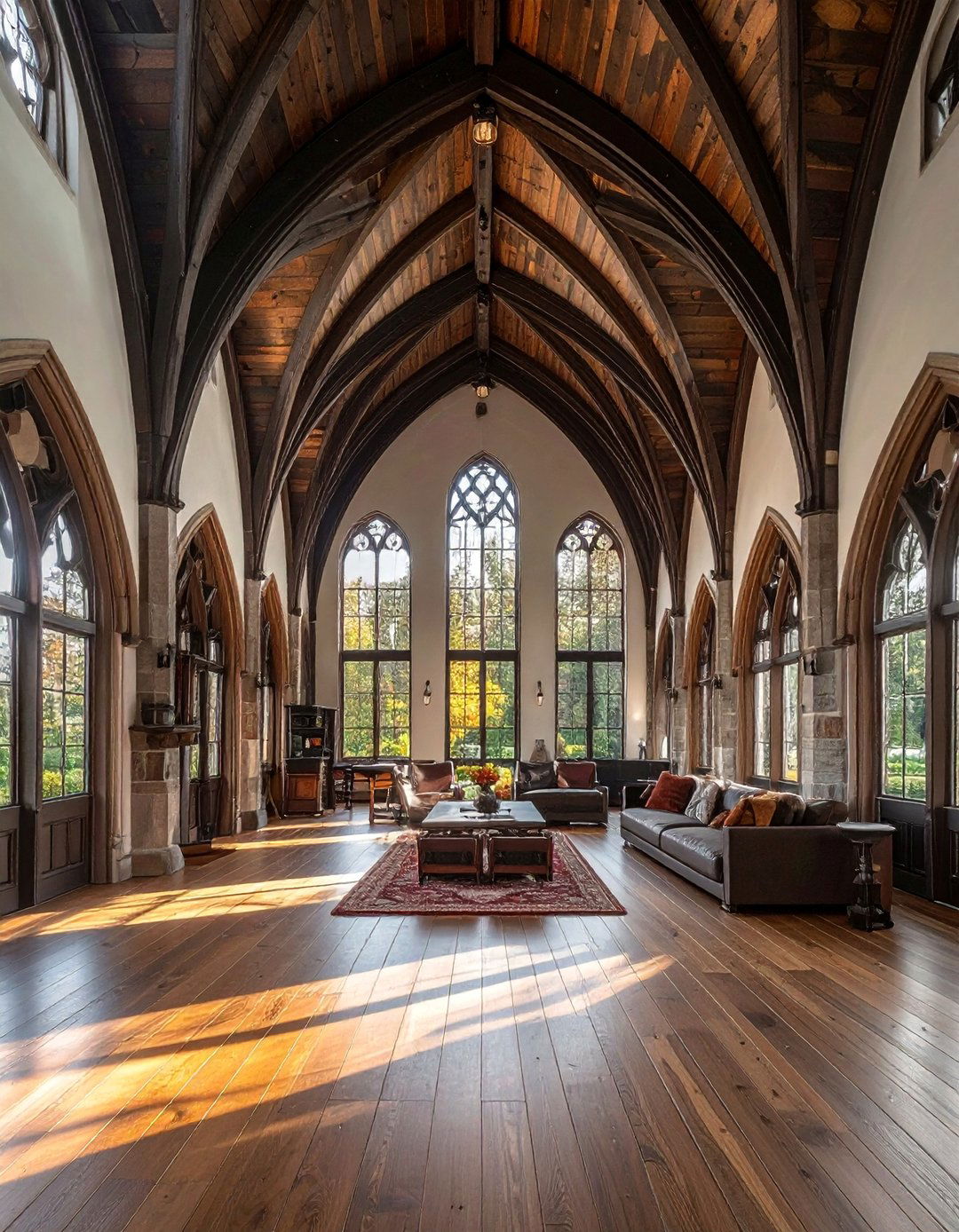
Inside a Gothic-inspired home, nothing conveys a sense of grandeur quite like soaring vaulted ceilings. Ribbed or barrel vaults, characteristic of medieval cathedrals, draw the eye upward, creating an expansive and airy feel despite the style's often moody palette. These architectural marvels can be crafted from exposed dark wood beams, plaster, or stone to match the home's overall aesthetic. In a great room or master bedroom, a vaulted ceiling transforms the space into a majestic hall, enhancing acoustics and providing a stunning canvas for dramatic chandeliers or pendant lighting. This element is fundamental to achieving the verticality and awe-inspiring scale of true Gothic design.
4. Stained Glass Windows with Tracery
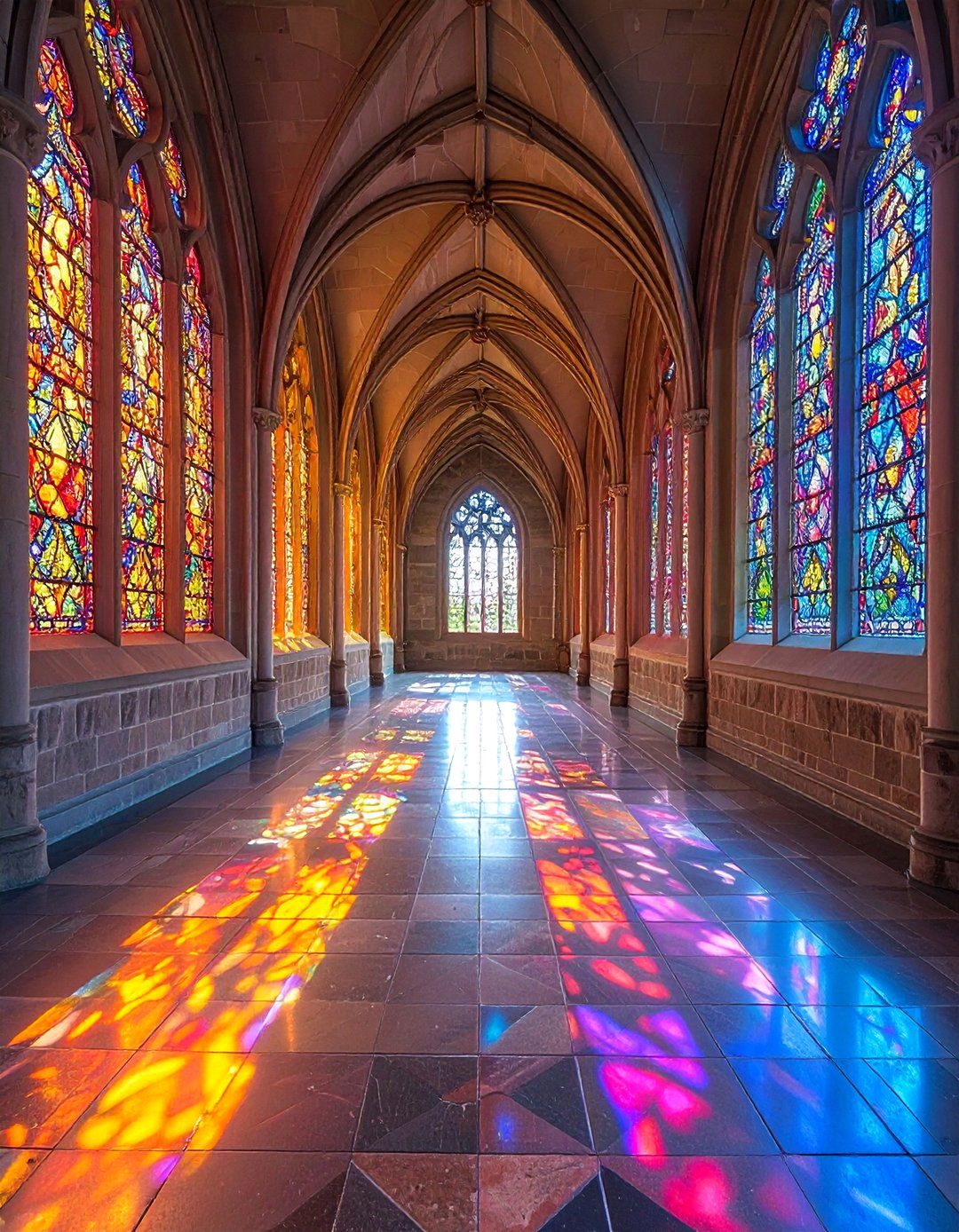
Stained glass windows are a quintessential element of Gothic design, infusing interiors with colored light and narrative beauty. For a home, these can be incorporated in key areas like the entryway, staircase landing, or library. The designs don't have to be overtly religious; they can feature geometric patterns, nature-inspired motifs, or abstract art in deep jewel tones like ruby red, sapphire blue, and emerald green. The intricate stone or wood tracery that holds the glass is just as important, creating delicate, web-like patterns that are beautiful even in silhouette. These windows serve as functional art, casting ethereal patterns that shift throughout the day.
5. Towering Castle Turrets and Battlements
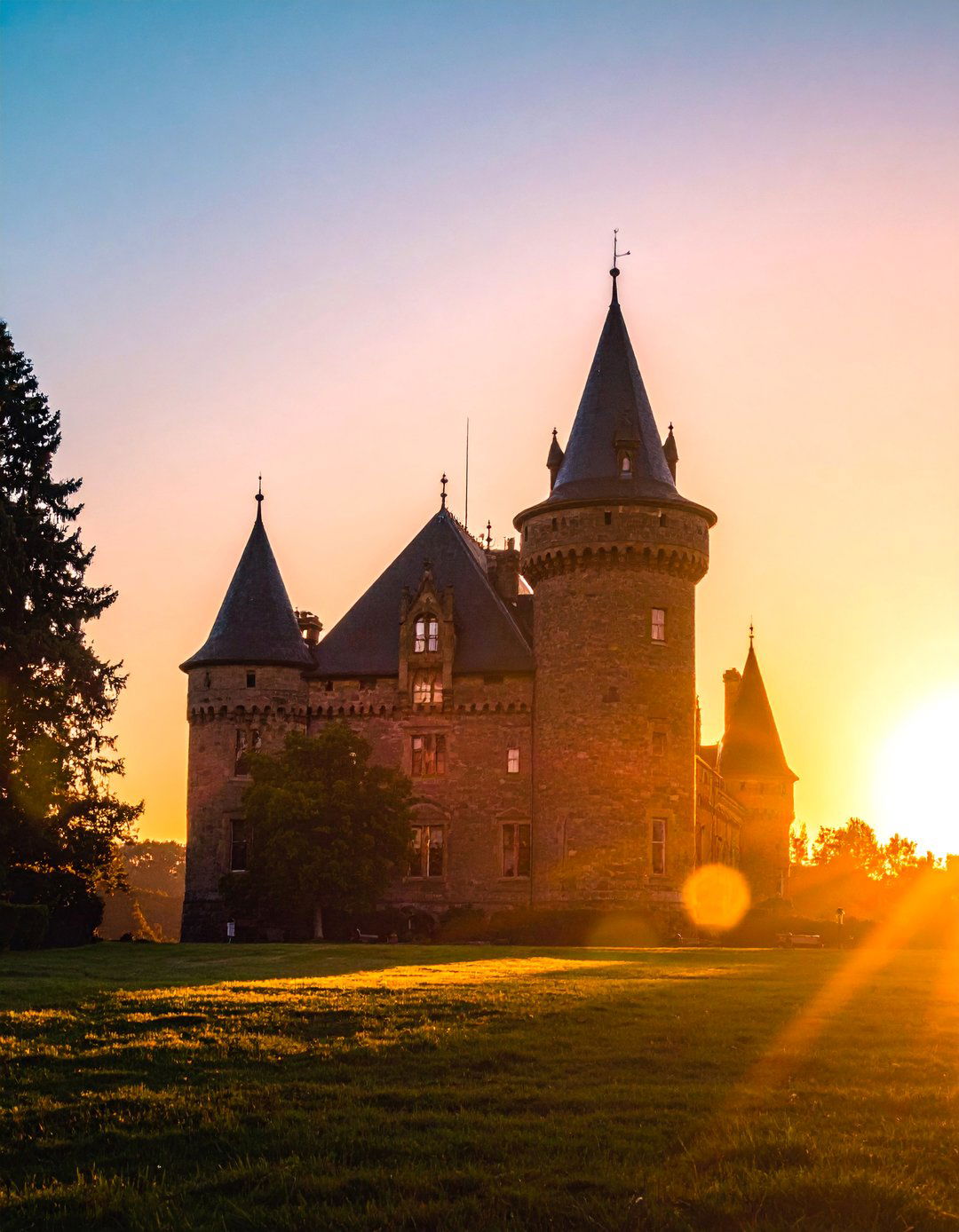
For a truly authentic castle silhouette, incorporating a turret or two is essential. These cylindrical or square towers can be functional, housing a spiral staircase, a cozy reading nook, or a private study with panoramic views. Capping the roofline with decorative battlements—the classic notched parapets—further enhances the fortress-like appearance. While once used for defense, today's battlements are a purely aesthetic choice that adds a powerful architectural statement. Together, turrets and battlements break up the horizontal lines of the home, adding vertical drama and creating an unmistakable profile that is both romantic and formidable against the skyline.
6. Dramatic Spiral Staircase
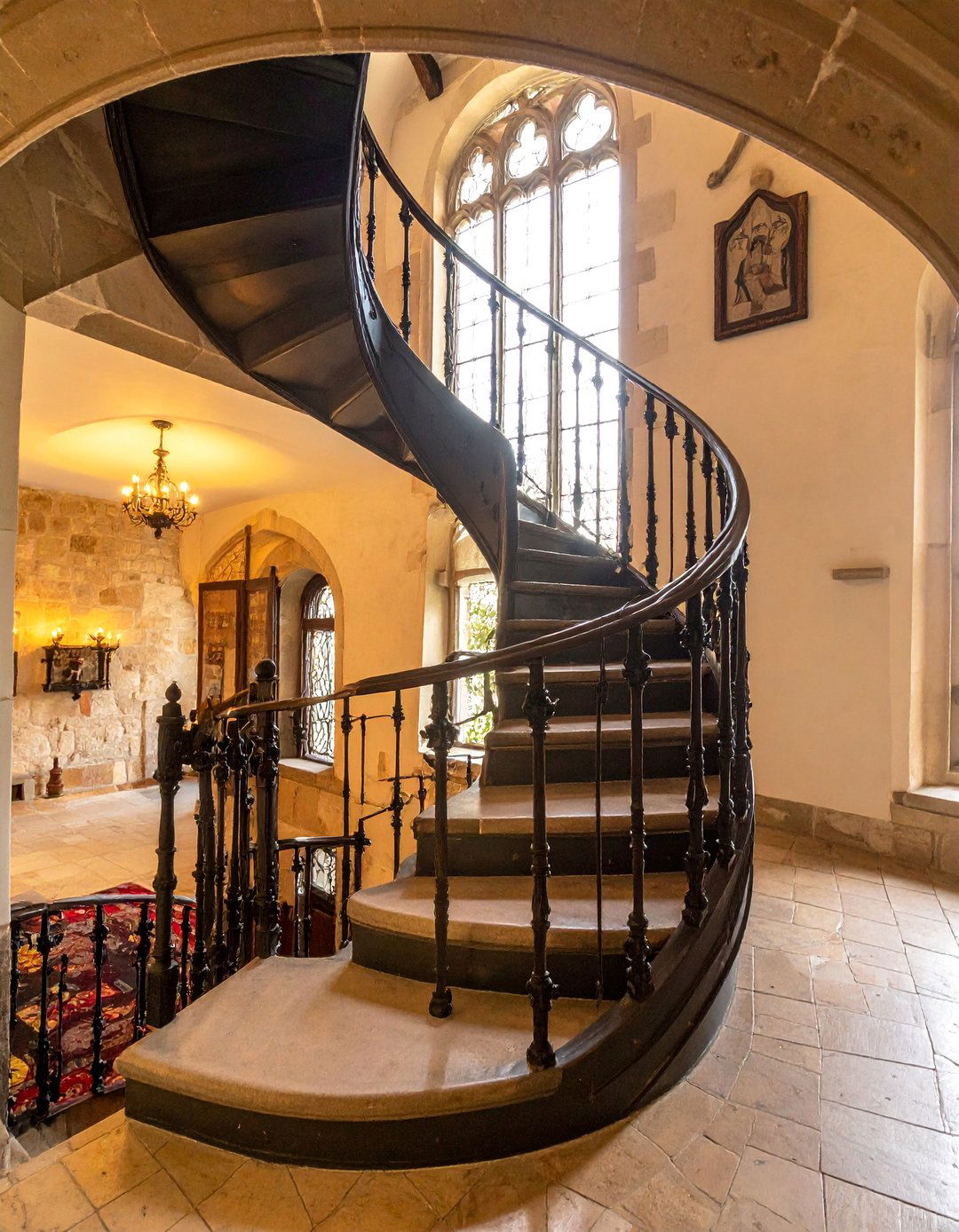
A spiral staircase serves as a stunning and functional centerpiece in a Gothic-inspired home. Constructed from dark, heavy wood, cast iron, or stone, it winds its way up through the floors, often housed within a turret. The design can be intricate, with ornate balusters, a carved newel post, and a heavy handrail that feels substantial to the touch. This feature not only saves space compared to a traditional grand staircase but also adds an element of mystery and discovery. As it ascends, it offers changing perspectives of the surrounding space, making the journey between floors a dynamic architectural experience.
7. Grand Fireplace with Ornate Mantel
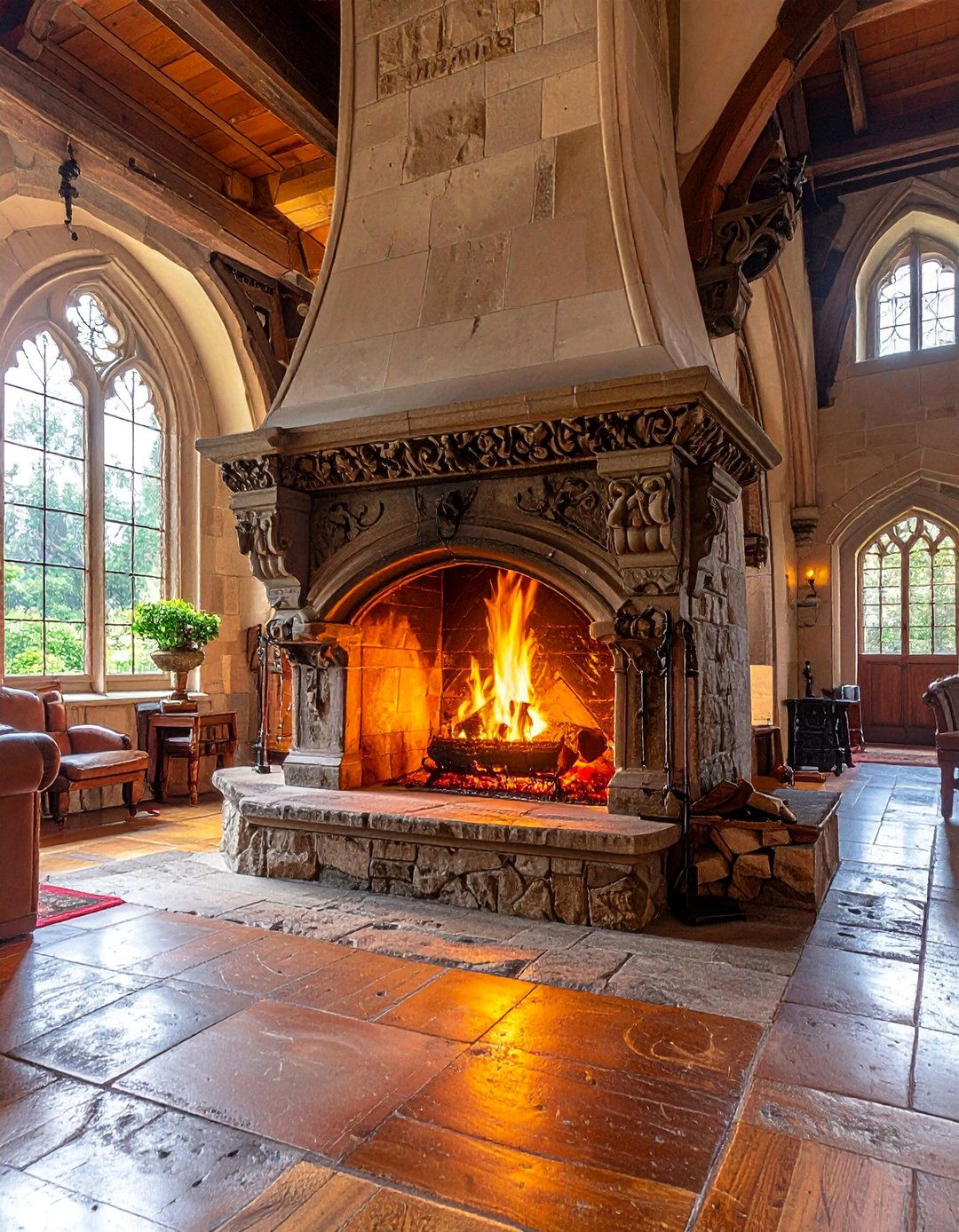
The fireplace is the heart of a Gothic home, and it should be appropriately grand and imposing. A floor-to-ceiling fireplace constructed from rough-cut stone or intricately carved dark wood commands attention in any great room or master suite. The mantelpiece can be adorned with Gothic motifs like quatrefoils, trefoils, or even small, sculpted gargoyles for a touch of medieval fantasy. A deep firebox allows for a roaring fire, creating a warm and inviting atmosphere that contrasts with the cool stone and vast spaces. This feature is not just a heat source but a powerful focal point for social gatherings.
8. Exposed Interior Stone Walls

Bringing the exterior stone inside creates a seamless transition and reinforces the castle theme. An exposed stone accent wall in the living room, dining area, or master bedroom adds texture, ruggedness, and a sense of ancient history to the interior. The natural, cool tones of the stone provide a perfect backdrop for rich tapestries, ornate mirrors, or antique artwork. When paired with dark wood floors and ceiling beams, the stone walls create a cozy, cavern-like feel that is both protective and dramatic. Leaving the stone untreated preserves its natural imperfections, adding to the home’s authentic, time-worn character.
9. Dark Hardwood Flooring and Paneling

Rich, dark hardwood is fundamental to achieving the moody and opulent atmosphere of a Gothic interior. Wide planks of oak, walnut, or ebony-stained wood for the floors ground the space with a sense of permanence and warmth. This can be complemented by full or partial wall paneling in the same dark wood, particularly in rooms like the library, study, or dining hall. The paneling can be left simple or carved with intricate Gothic patterns. This extensive use of dark wood absorbs light, creating an intimate and dramatic ambiance that feels both luxurious and historically accurate, perfectly complementing the stone and iron elements.
10. Library with Floor-to-Ceiling Bookshelves

A Gothic-style home is the perfect setting for a magnificent library. Imagine a room with floor-to-ceiling bookshelves crafted from dark, carved wood, accessible by a rolling ladder. The shelves should be filled with leather-bound books, creating a rich tapestry of color and texture. A heavy wood desk, comfortable leather armchairs, and a fireplace with an ornate mantel would make the space both functional and atmospheric. A large window, perhaps with a pointed arch or stained glass accents, would provide natural light for reading, while dim, warm lighting from wrought-iron sconces would create the perfect evening ambiance for scholarly pursuits.
11. Four-Poster Bed with Heavy Drapes

In the master bedroom, a massive four-poster bed serves as the dramatic focal point. The frame should be constructed from dark, heavily carved wood with tall, substantial posts. To enhance the sense of enclosure and luxury, the bed can be dressed with heavy drapes made of velvet, brocade, or tapestry fabric in deep, rich colors like burgundy, forest green, or royal purple. These curtains can be drawn for privacy and warmth, creating a cozy sanctuary within the larger room. This centerpiece furniture not-only provides comfort but also reinforces the opulent and theatrical aesthetic of the Gothic castle theme.
12. Use of Rich, Jewel-Toned Textiles
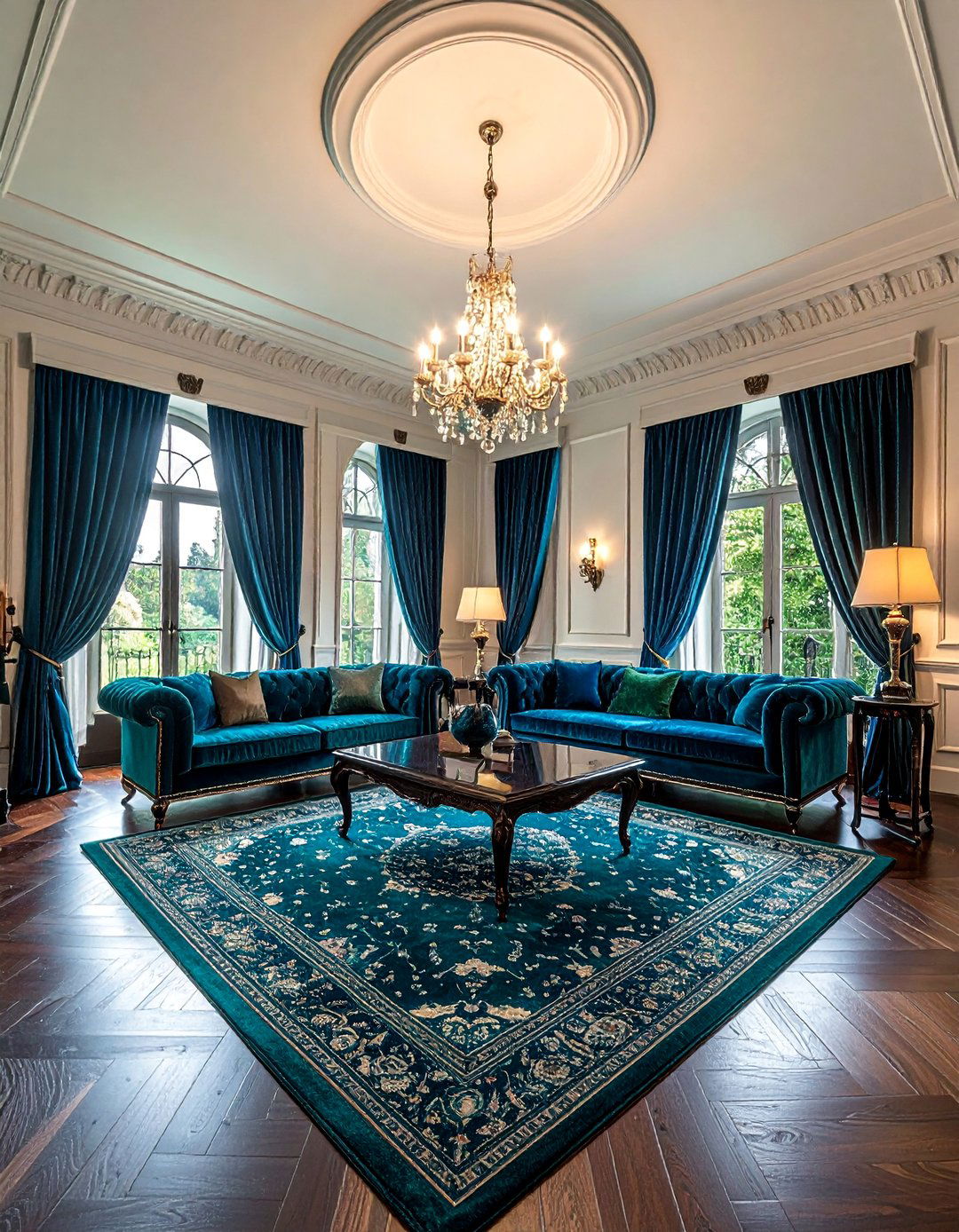
While the core palette of a Gothic home leans towards dark woods and grey stones, richness is added through textiles in deep jewel tones. Heavy velvet curtains, plush area rugs, and opulent upholstery in sapphire blue, ruby red, emerald green, and amethyst purple create a sense of regal luxury. Tapestries depicting medieval scenes, floral patterns, or heraldic symbols can be hung on stone walls to add color, texture, and narrative detail. These vibrant accents contrast beautifully with the darker, more stoic architectural elements, bringing warmth and a touch of decadent comfort to the grand spaces of the home.
13. Wrought Iron Chandeliers and Sconces
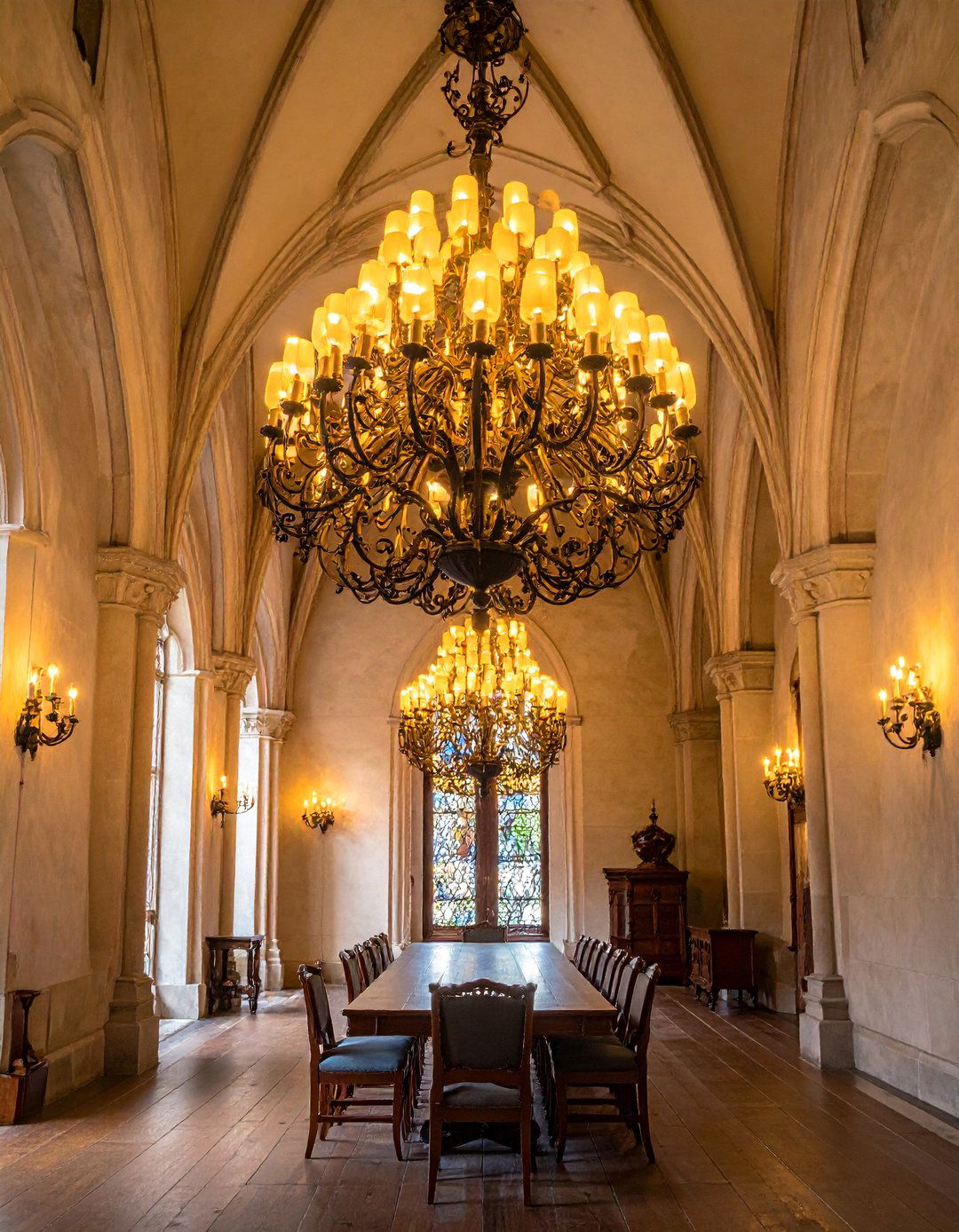
Lighting is crucial for creating the right mood in a Gothic castle home. Large, imposing chandeliers made of wrought iron or cast bronze should hang from the vaulted ceilings of great rooms and dining halls. These fixtures often feature candelabra-style bulbs to mimic the look of candlelight, casting a warm, flickering glow. Wall sconces of a similar design can be used to illuminate hallways and smaller rooms, their light playing off the texture of stone walls. The dark, heavy metal of these fixtures provides a stark contrast to the light they emit, enhancing the overall dramatic and historic atmosphere.
14. Integrated Modern Kitchen with Gothic Details

A modern, functional kitchen can be seamlessly integrated into a Gothic design without breaking character. Custom cabinetry can be crafted from dark wood with details like pointed arch reliefs or quatrefoil cutouts. A large, stone-clad island with a thick butcher block or soapstone countertop can serve as a central workspace. To hide modern appliances, consider custom panels that match the cabinetry. A wrought-iron pot rack hanging from the ceiling and a faucet in a dark, antique brass or oil-rubbed bronze finish would complete the look, blending contemporary convenience with timeless medieval style for a space that is both practical and atmospheric.
15. Luxurious Bathroom with a Clawfoot Tub

Transform a bathroom into a Gothic sanctuary with a dramatic freestanding clawfoot tub as the centerpiece. Position it beneath a stained-glass window for an ethereal bathing experience. The walls can be a combination of dark, waterproof plaster and stone tile, while the floor could feature intricate black-and-white mosaic patterns. A vanity crafted from dark wood with an ornate mirror and wrought-iron sconces adds to the ambiance. Fixtures in an antique brass or matte black finish will complement the historic aesthetic. This space should feel like a private chamber for relaxation, blending luxury with moody, medieval elegance.
16. Hidden Passageways and Secret Rooms
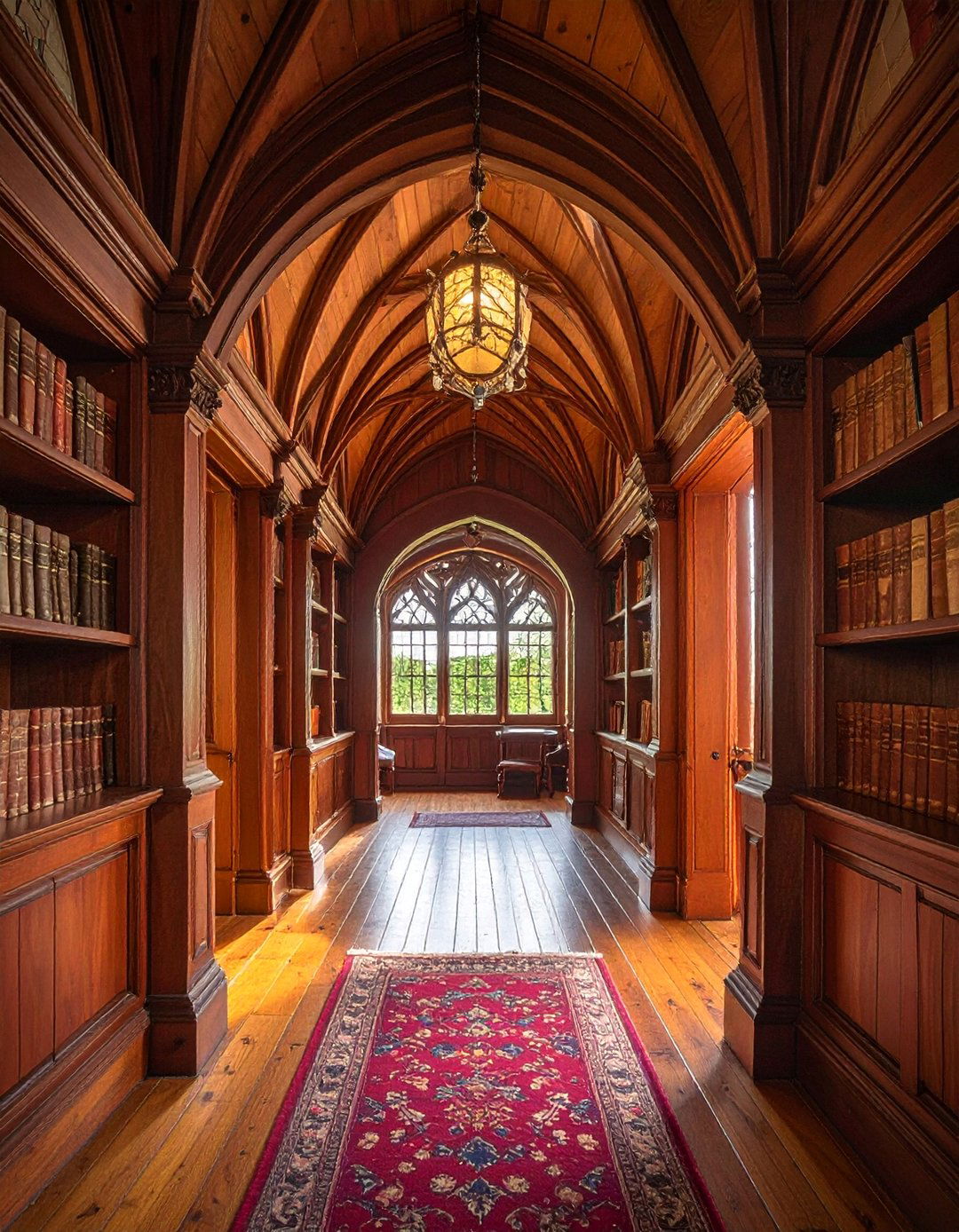
For a touch of authentic castle mystery, incorporate a hidden passageway or a secret room into the home's design. A common execution is a bookcase that swings open to reveal a hidden study, a media room, or a secure safe room. The trigger mechanism can be a tilted book, a hidden latch, or a discreet button. This element adds a playful and imaginative layer to the home, sparking curiosity and a sense of adventure for both residents and guests. It's a nod to the clandestine nature of historic castles, making the house not just a dwelling but a place of discovery.
17. Outdoor Gargoyles and Grotesques

Extend the Gothic theme to the home's exterior with the addition of gargoyles and grotesques. These carved stone figures, traditionally used as decorative waterspouts on medieval buildings, can be placed along the roofline, above doorways, or perched on garden walls. While historically meant to ward off evil spirits, they now serve as powerful, artistic symbols of the Gothic style. They can range from classic demonic figures to whimsical animals or mythical creatures, adding a layer of fantasy and architectural detail that is both authentic and conversation-starting, giving the home a distinct and memorable personality.
18. Formal Dining Hall with a Long Banquet Table
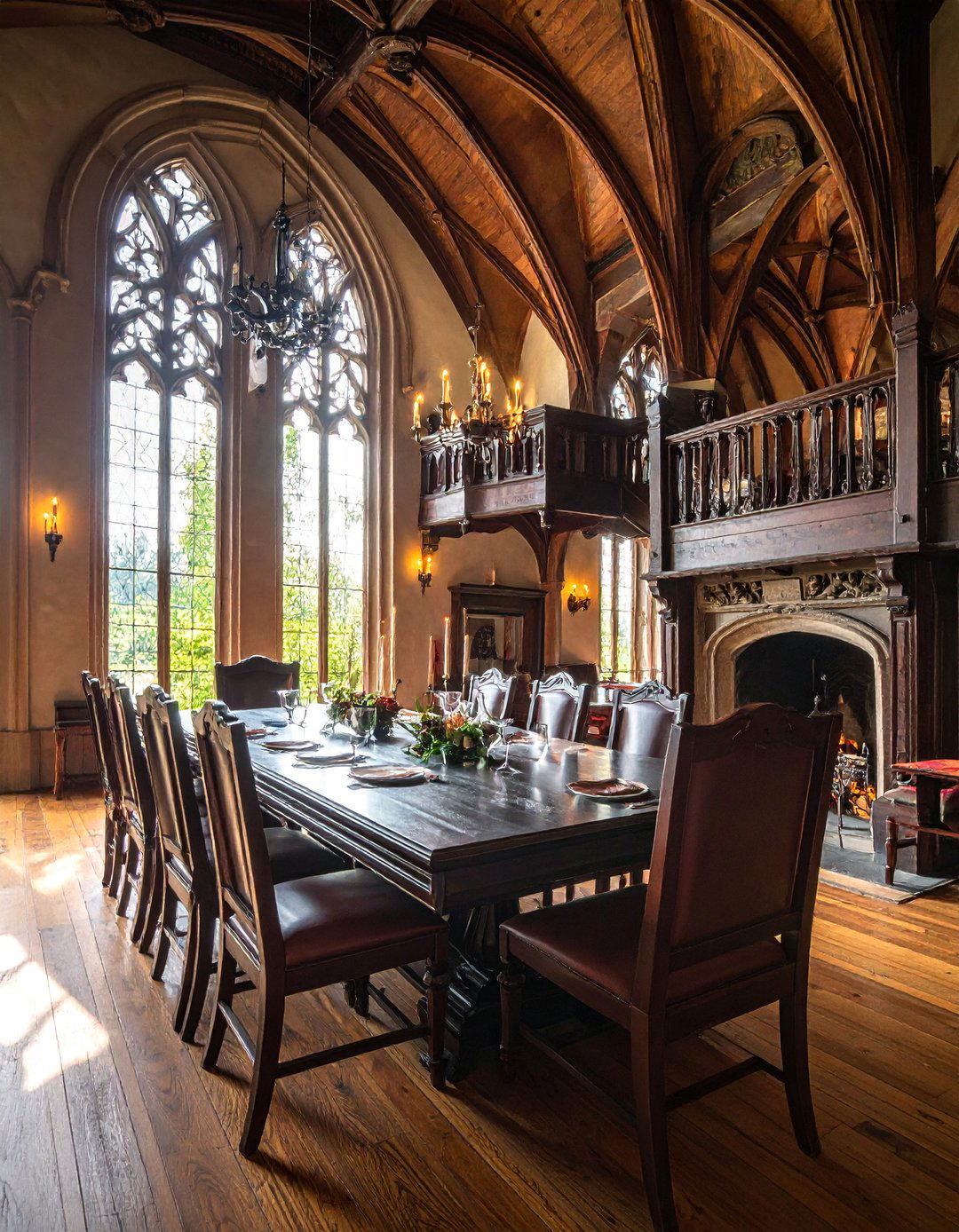
A Gothic castle home demands a dining space that is fit for a feast. A formal dining hall should feature a long, heavy banquet table made from a single slab of dark wood or reclaimed timber. High-backed, throne-like chairs, upholstered in rich velvet or leather, line the table. The room itself should have a high, perhaps vaulted, ceiling from which a massive wrought-iron chandelier hangs. A grand fireplace at one end of the room and large tapestries on the stone walls would complete the medieval atmosphere, creating an impressive setting for hosting memorable dinners and grand celebrations.
19. A Private Study or Scriptorium
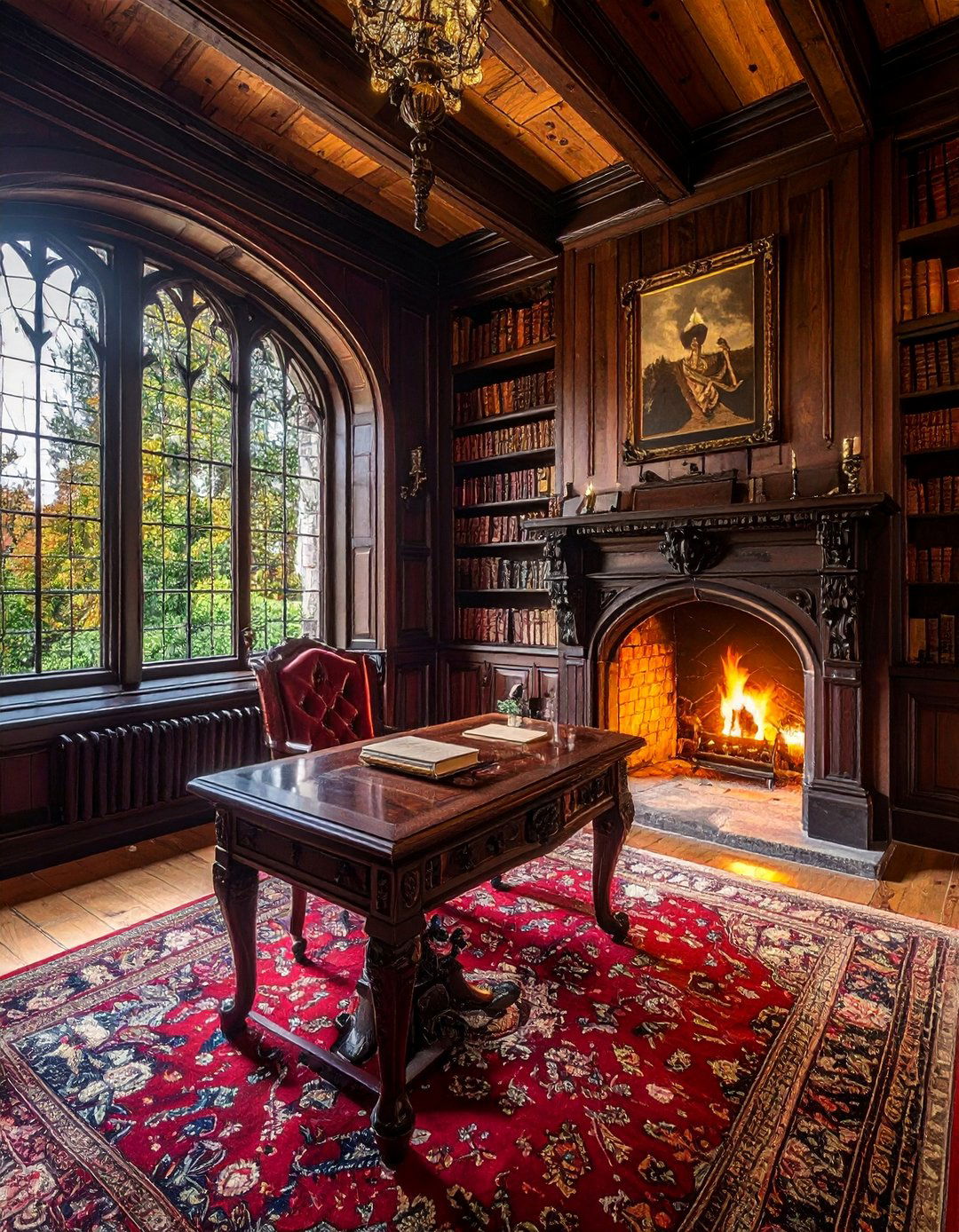
Create a secluded space for contemplation and work with a private study designed as a modern scriptorium. This room should feature dark wood paneling, a heavy, carved desk, and built-in bookshelves filled with classic literature and reference materials. Lighting should be intimate, with a green-shaded banker's lamp on the desk and strategically placed wall sconces. A comfortable leather armchair beside a small fireplace offers a place for reading and reflection. A window with leaded or stained glass can look out onto a quiet part of the garden, making it the perfect scholarly retreat from the rest of the world.
20. Gothic Archway Interior Doors
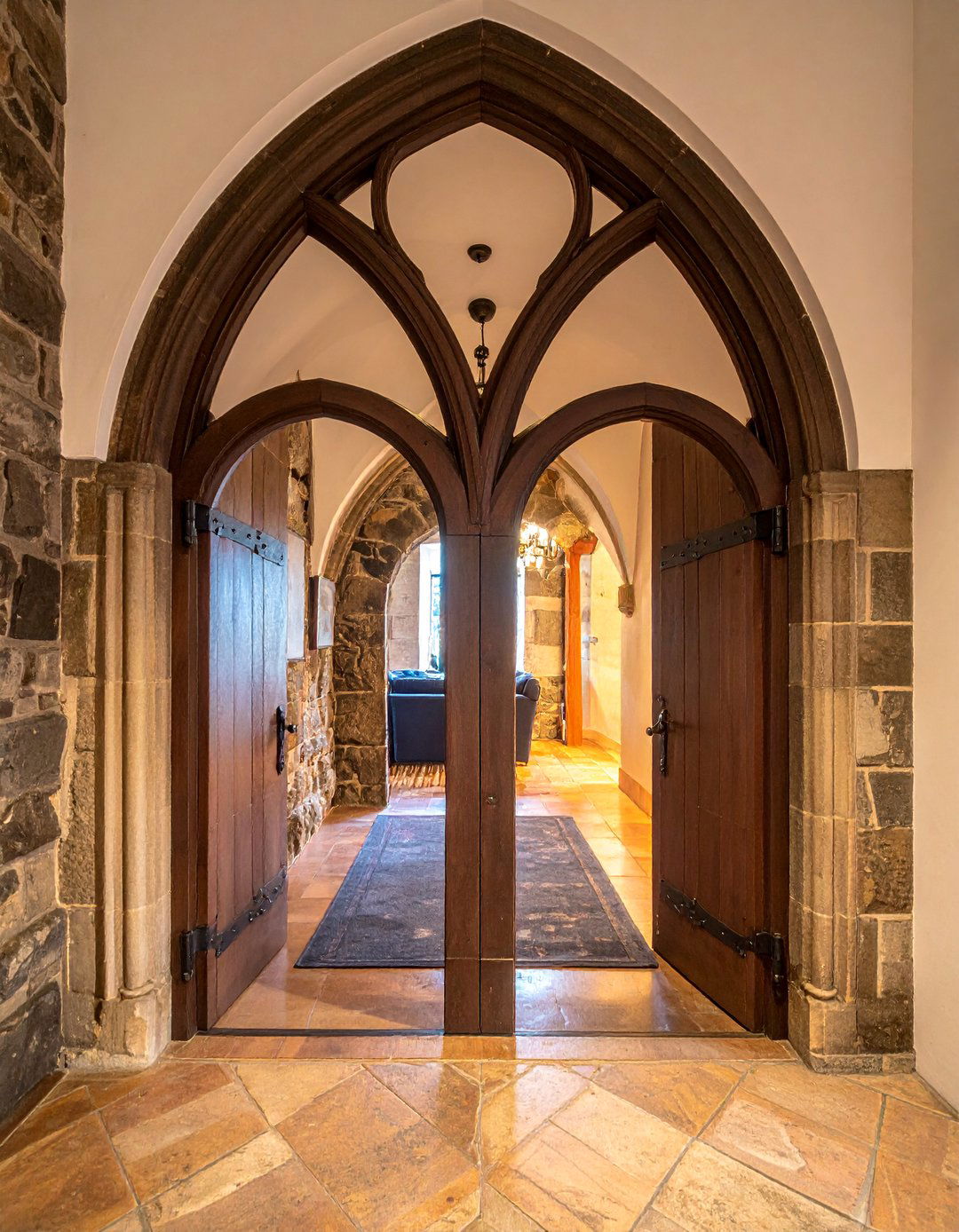
Carry the iconic pointed arch motif throughout the interior by using Gothic-style archways for doorways and passages between rooms. These can be simple, plaster-finished arches or more elaborate, cased openings made from dark, carved wood. The shape itself inherently draws the eye upward and adds architectural interest, making even a simple hallway feel grand. Using heavy, solid wood doors with iron strap hinges and latches within these archways further reinforces the castle-like feel. This consistent use of a core architectural element creates a cohesive and immersive design that flows from room to room.
21. Cobblestone Driveway and Walkways
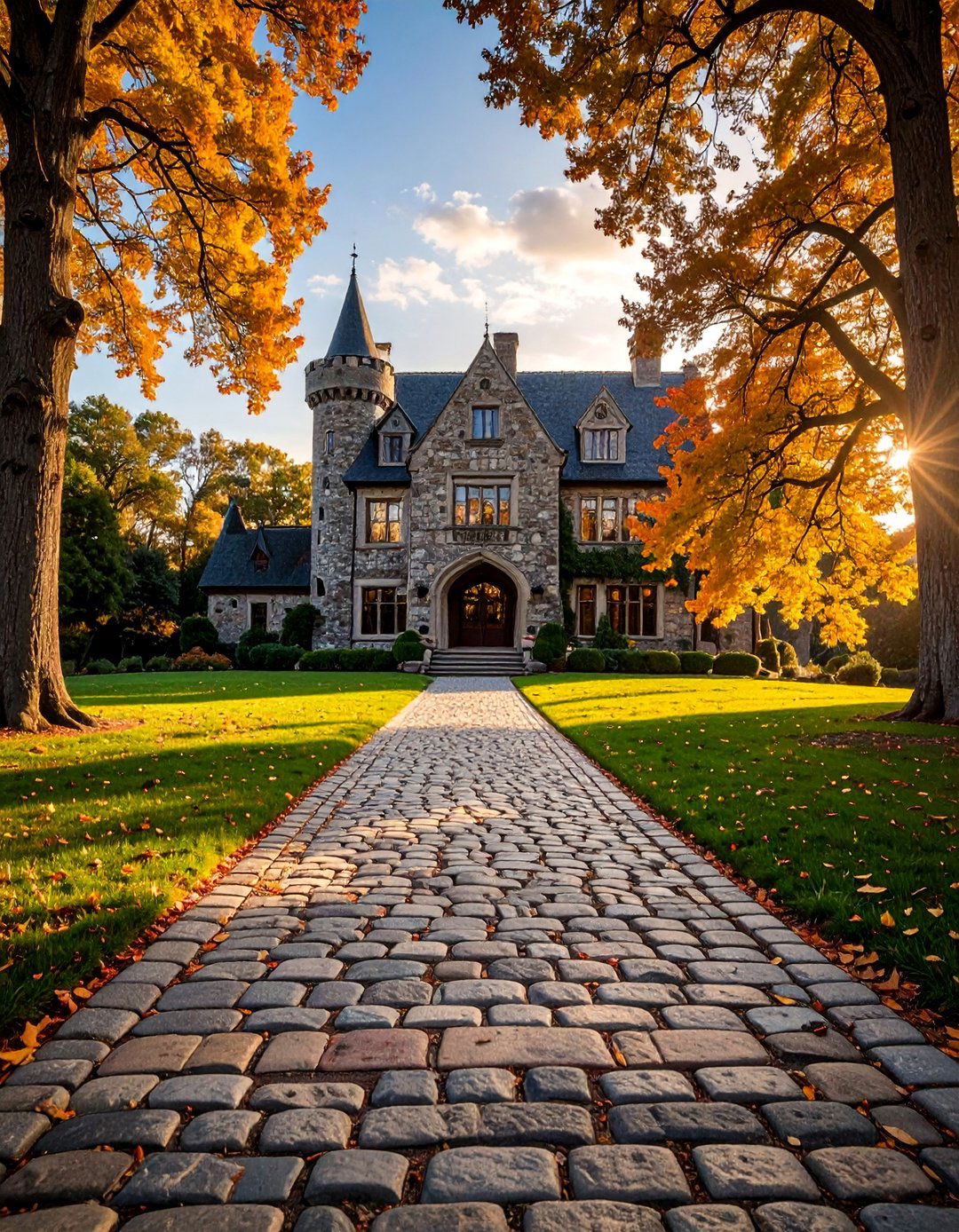
The approach to your Gothic castle should set the stage for what lies ahead. A driveway and walkways paved with natural cobblestones immediately evoke a sense of history and old-world charm. The irregular shapes and earthy tones of the stones create a textured, durable surface that feels authentic and timeless. Flank the driveway with mature trees and low, stone walls to enhance the sense of entering a private estate. As guests arrive, the sound and feel of driving over cobblestones provide a tactile experience that perfectly introduces the dramatic architecture of the home.
22. A Moat or Reflecting Pool
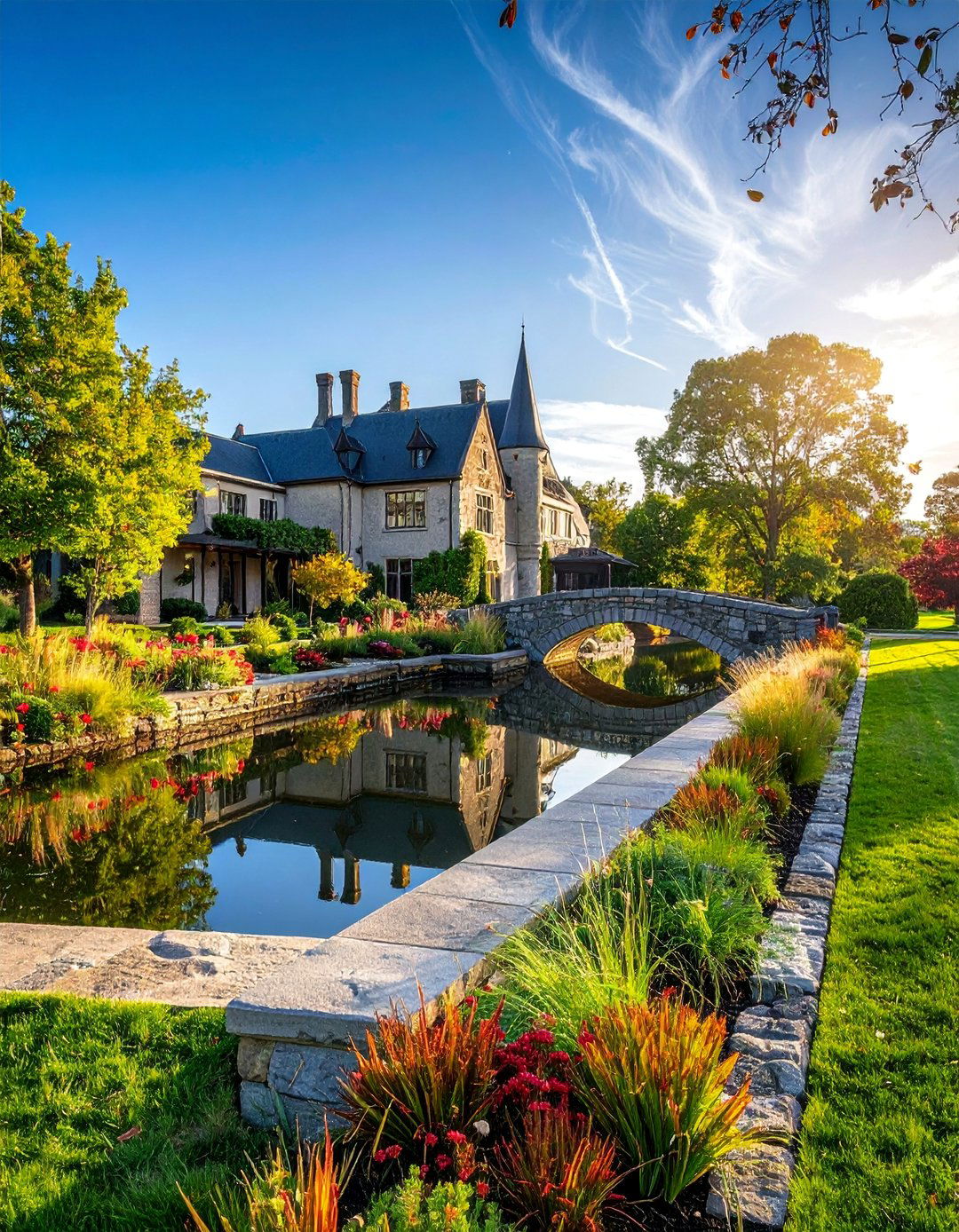
While a traditional defensive moat may be impractical, a modern interpretation in the form of a reflecting pool or a decorative water channel can create a stunning visual effect. Surrounding the front or a portion of the home, this water feature can reflect the dramatic silhouette of the castle, amplifying its grandeur. A stone bridge could lead across the water to the main entrance, adding to the ceremonial approach. The still water adds a sense of tranquility that contrasts with the imposing architecture, while also providing a beautiful and unique landscape element that pays homage to classic castle design.
23. An Indoor Courtyard or Atrium
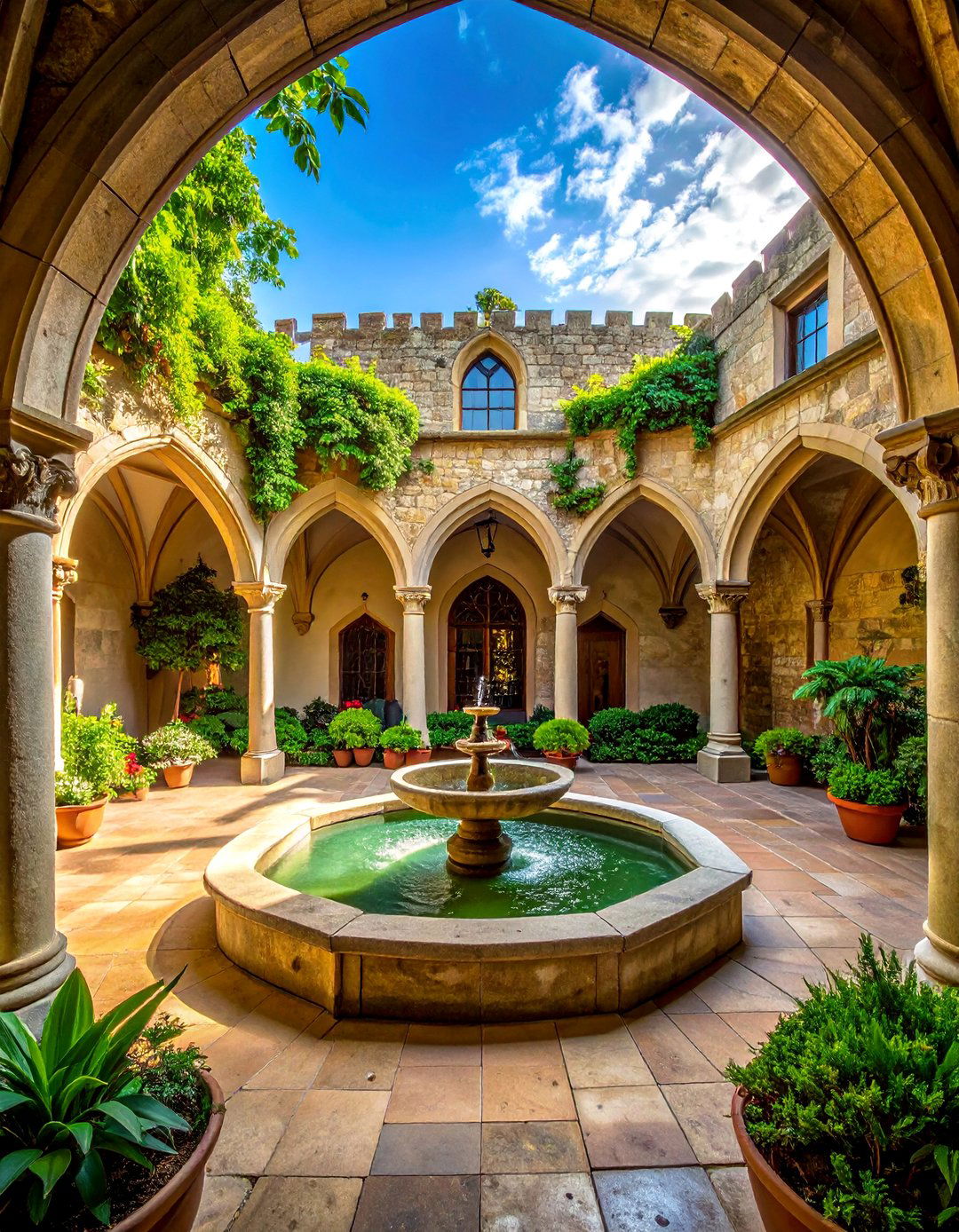
Create a protected, private outdoor space within the home's footprint with an indoor courtyard or atrium. Enclosed by stone walls and large arched windows, this area can be a tranquil garden filled with shade-loving plants, a fountain, and stone benches. A retractable glass roof could allow for enjoyment in any weather. This feature brings nature into the heart of the home, providing a bright, serene contrast to the darker, more dramatic interiors. It serves as a personal sanctuary for quiet reflection and a beautiful, light-filled space that feels both connected to the outdoors and securely enclosed.
24. A Wine Cellar with Stone Archways
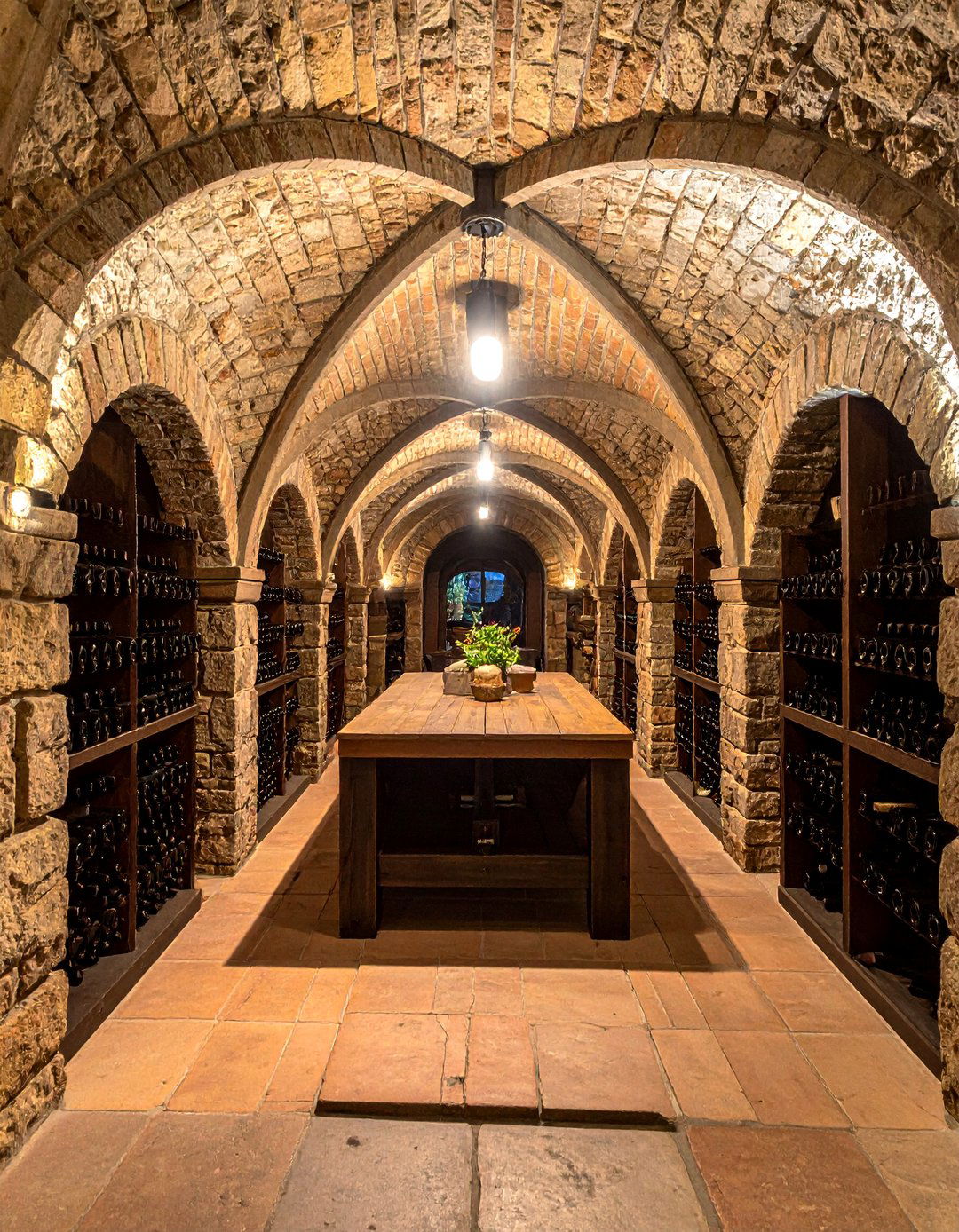
Below the main living areas, a wine cellar is a natural fit for a Gothic castle home. The cool, subterranean environment is ideal for storing wine, and the aesthetic can be enhanced with rough stone walls, barrel-vaulted ceilings, and brick or flagstone floors. Dark wood wine racks can be custom-built to fit into arched stone alcoves. A heavy, iron-strapped wooden door at the entrance reinforces the secure, underground feel. Add a small tasting area with a rustic table and high-backed chairs to create an atmospheric space for enjoying a collection in a truly medieval setting.
25. Themed Gardens with Gothic Ruins
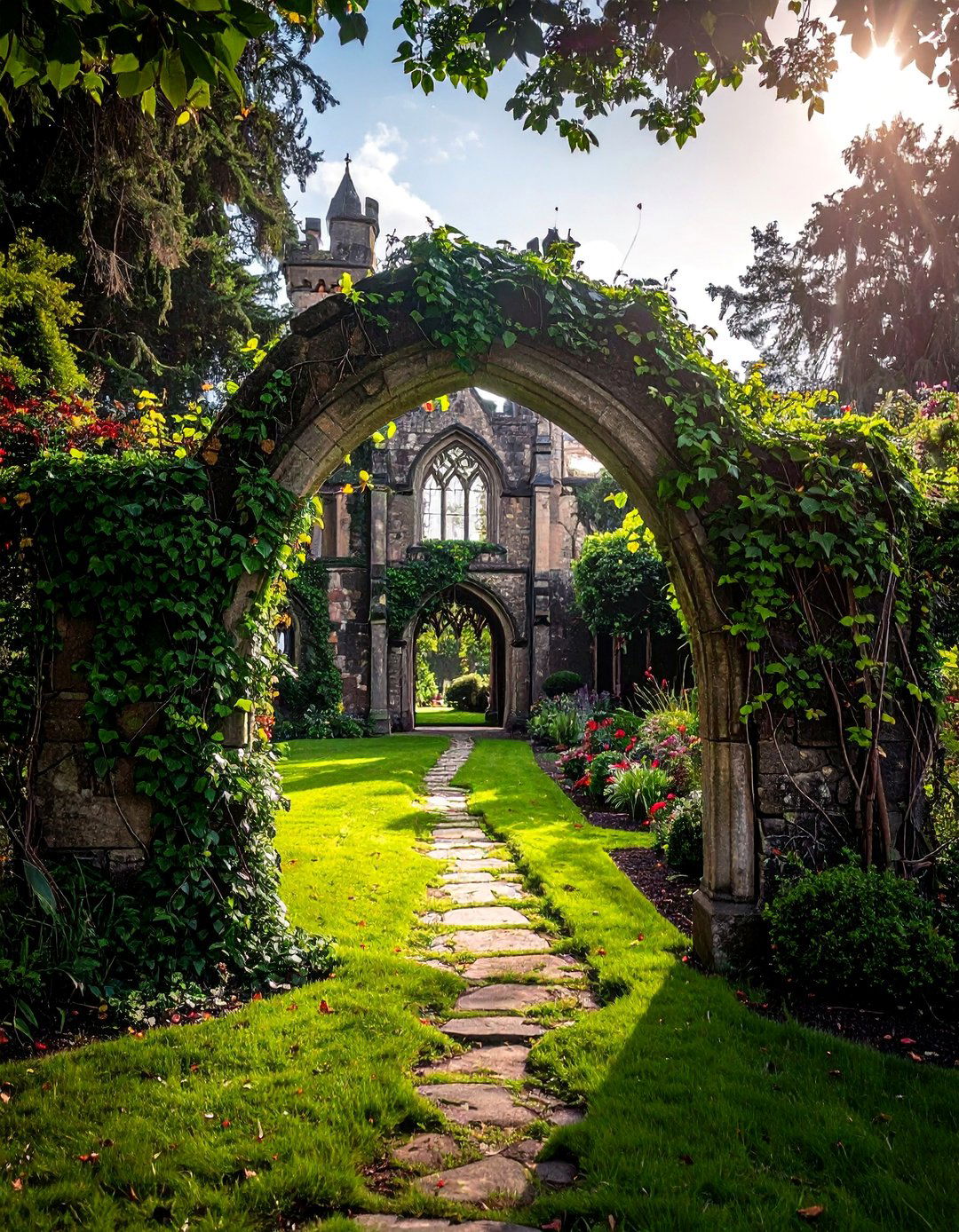
Extend the aesthetic to the landscape with themed gardens that complement the home's architecture. A formal garden with manicured hedges, stone pathways, and a central fountain can provide a sense of order. For a more romantic and mysterious feel, create a garden with faux "Gothic ruins"—a crumbling stone wall, a freestanding archway, or a small, weathered folly covered in ivy. Incorporate plants with dark foliage or deep-colored blooms, like black roses or dark purple irises. This creates a landscape that feels ancient and enchanting, as if it has been part of the property for centuries.
Conclusion:
Building a Gothic castle home is an exercise in creating a personal world of drama, history, and unique character. By thoughtfully integrating key elements like pointed arches, stone facades, vaulted ceilings, and wrought iron details, a residence can be transformed into a modern fortress of unparalleled style. Each feature, from a grand fireplace to a secret passageway, contributes to a cohesive and immersive experience. The result is not just a house, but a deeply atmospheric sanctuary that stands as a bold statement of individuality and a timeless tribute to one of history's most captivating architectural styles.


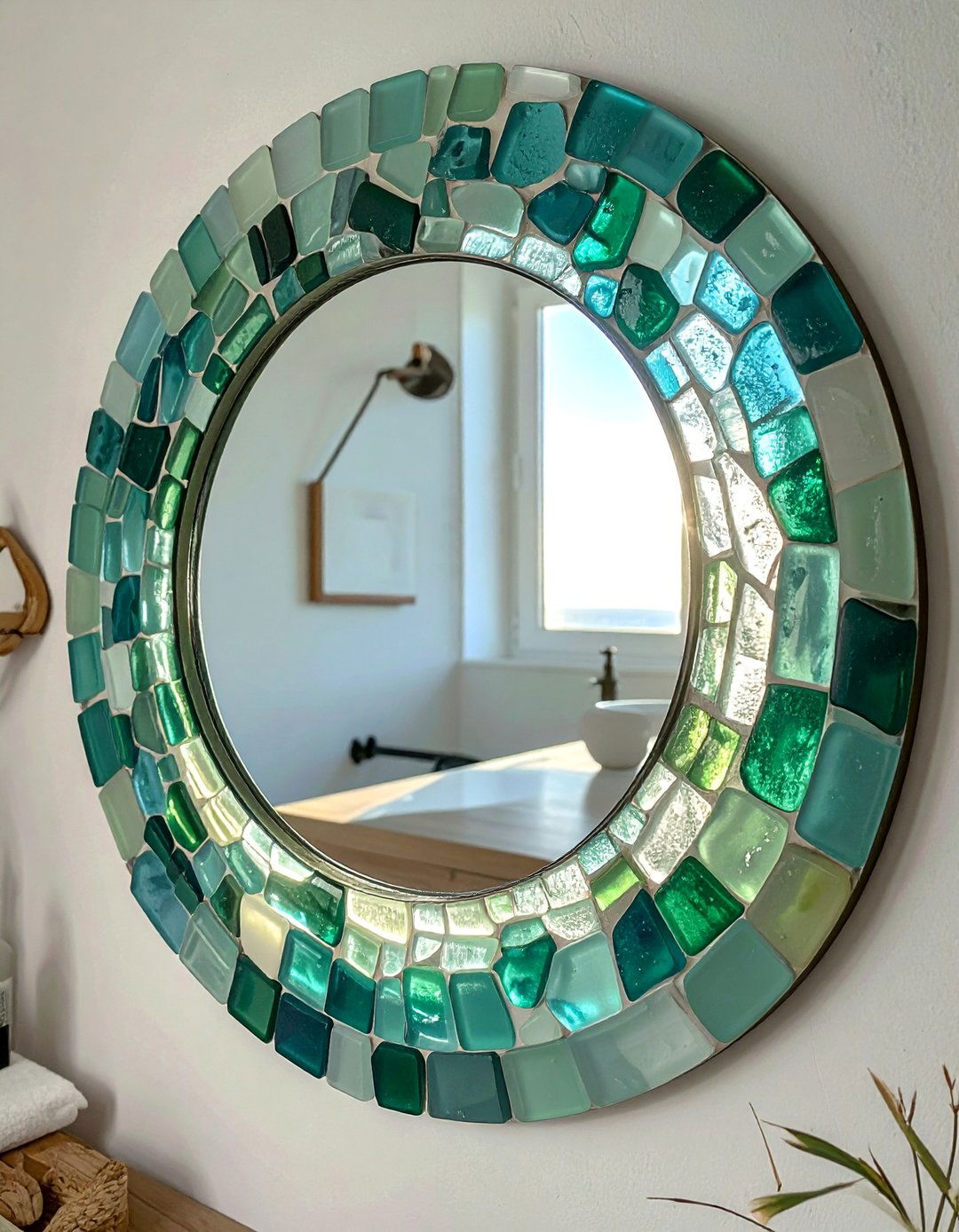
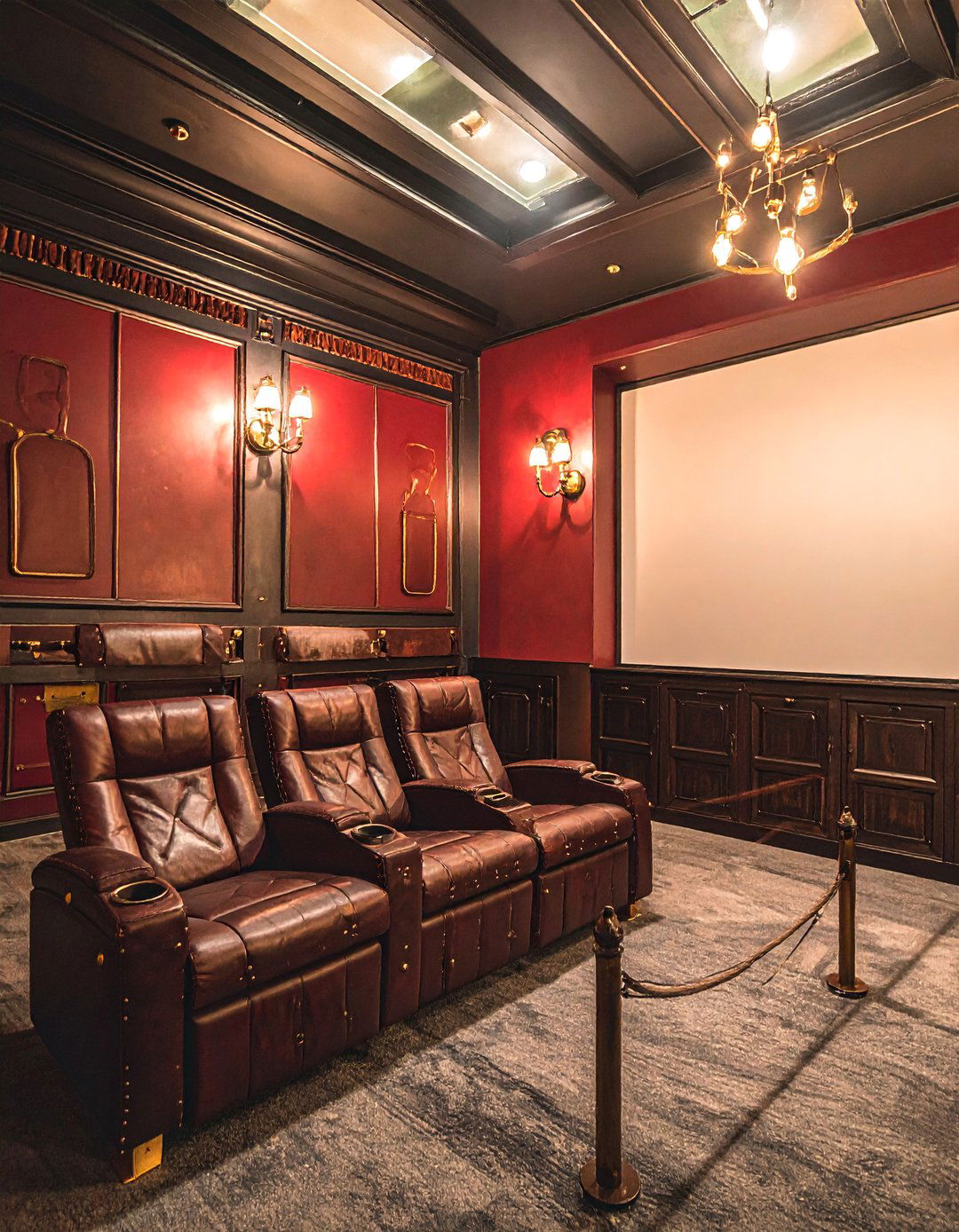

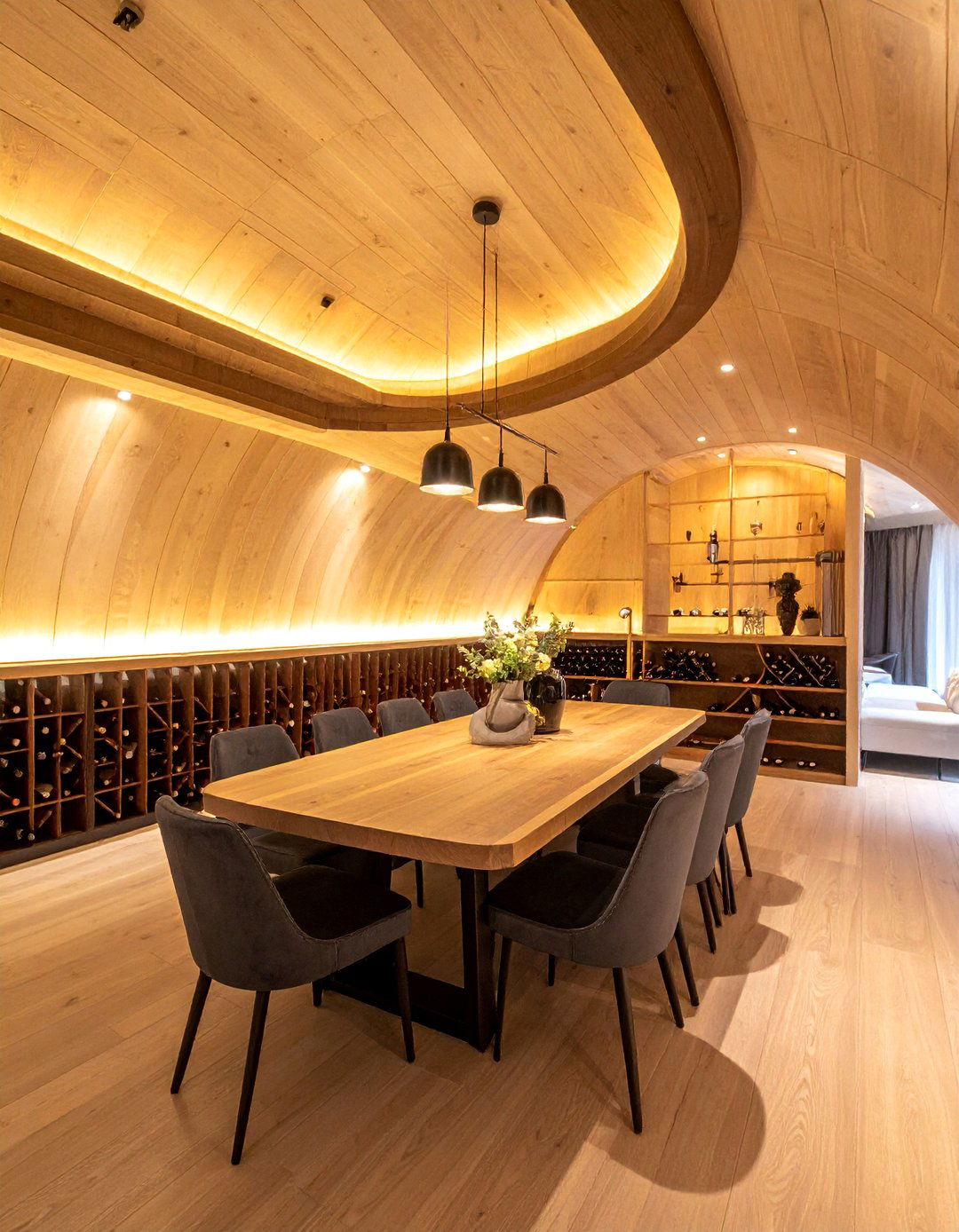
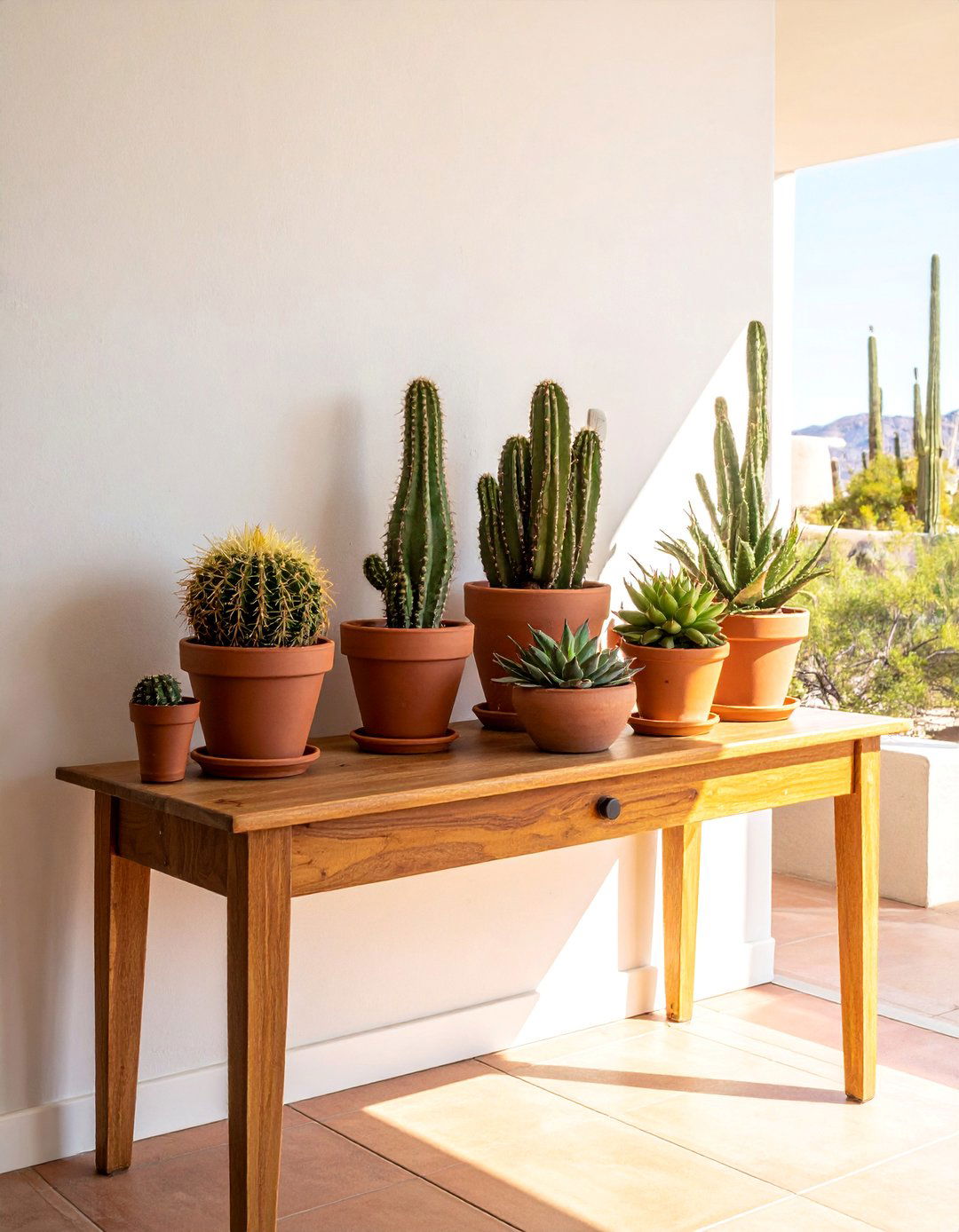
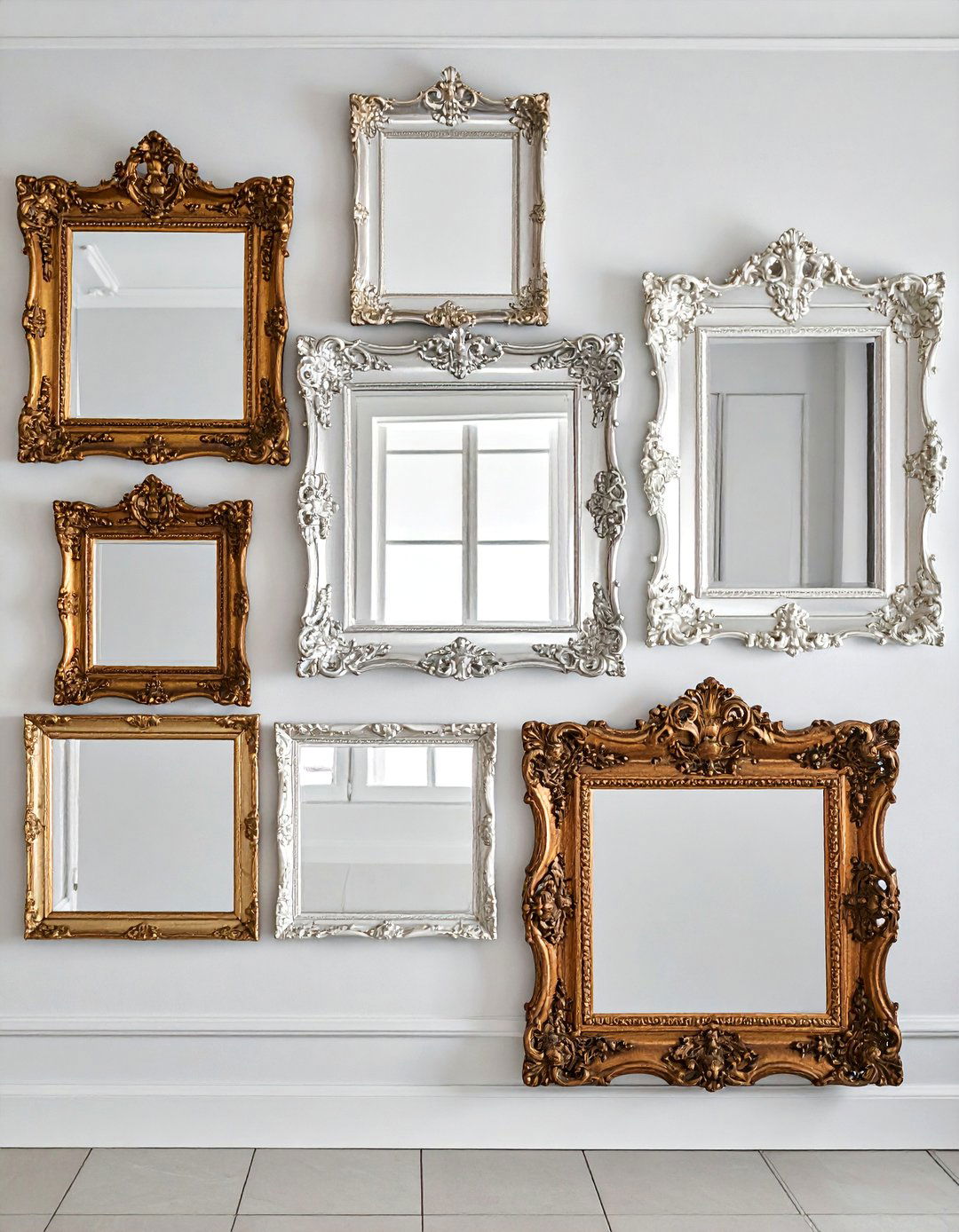

Leave a Reply